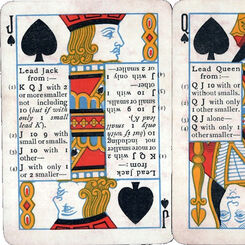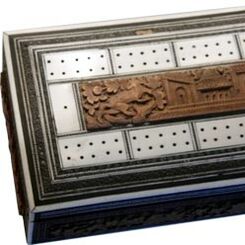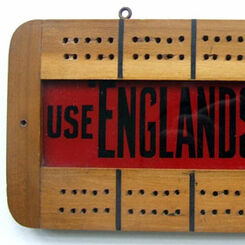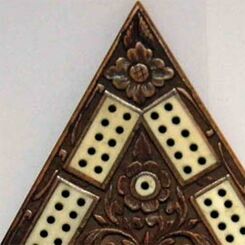Why do we Collect? My 20 Favourite Items
I suppose people collect for different reasons, rarity, quality, ingenuity of design, sentimental value... by Tony Hall.

Above: Tony Hall in 2019.
“I suppose people collect for different reasons: rarity, quality, ingenuity of design, sentimental value... ”
I have been collecting items connected to card play for many years and my various collections contain hundreds of pieces all of which have a part to play in the social history of card games. I have written about a number of these collections on wopc.co.uk over recent years.
I have frequently been asked (by anyone who doesn’t immediately glaze over when I talk about my hobby) which are your favourite items? Mostly this was probably due to people seeking to cut short any protracted attempt on my part to interest them in the history of games. Nevertheless, it got me thinking about which were my favourite collectables, and, if so, what criteria would I use to choose them? I thought let’s see if I can limit my choices to my favourite 20, perhaps 1% of the total, a task which has proved more difficult than I care to admit.
I am particularly attracted by quality. The workmanship on some of my items is extraordinary. Beautifully handcrafted wood and leather conjures lovely images of 19th century craftsmen and women expressing themselves with skills few would be able to exercise today. Ingenuity of design is also a big draw. When competing in a crowded market-place for custom, 19th century inventors produced some wonderful designs, most of which work today as well as they did when they were sold well over a century ago. I love items which individually or with others tell a story. I have always been fascinated by the evolution of whist through various stages to the modern game of contract bridge. Any collection of favourites must draw from this narrative.
Collectors are always on the lookout for the unusual. There are so many items which, despite their age, are commonplace because so many were produced in their heyday. So, it is nice to find something which is out of the ordinary. We also prize items in good condition. It is so good to find something which is perhaps 150 or 200 years old but which has been preserved in pristine fashion, looking as if it could have come straight from the original shop. However, just occasionally, an item may not be in great condition but is remarkable because it has survived the intervening years at all; rare survivors are much prized.
For me there are two other criteria which influenced my decision-making when selecting my twenty items. I prize items which are tactile, those which feel really good in the hands, and finally items which, for one reason or another, have sentimental value.
Most of my selection meet four of five of my eight criteria. My first choice, however, meets only one – sentiment.
Cribbage Boards

Above: this cribbage board is probably the tattiest and most unremarkable of the 150 or so boards I have collected. It is made of pine, with aluminium strips screwed into each end to hold the pegs. It is stained “Edwardian brown” and has nothing much going for it all .… except that it was the board on which my grandfather taught me how to play cribbage some seventy or so years ago. It was his enthusiasm for this game, and for just about all parlour and garden games, that lead me down a route of loving games and sport of all kinds.
Staying with the cribbage theme, my next choices are three boards associated with two world wars. The oldest is made of leather – black on the outside, yellow inside – with six metal pegs ingeniously contained in the black folding pouches inside.


Above: when folded it is no more than 9 x 5.5 cm, and opens to 18cm. It dates from WW1 and it is possible to imagine it being carried into the trenches to while away the waiting hours between attacks and uncomfortable sleep. If only such items could tell us their own story.
My next choice is an equivalent from WW2.

Above: it is beautifully crafted in thick brown leather, carefully stitched to protect it when closed, containing four brass pegs and carrying the initials of the unknown original owner. The outside shows signs of wear, the inside is in pristine condition, suggesting that this board at least did not see a great deal of action. When closed it is pocket-sized; 11.5 x 5.75 cm.
My fourth choice also dates from WW2 but has a much more identifiable personal history.

Above: the board is crudely made with an oak base and aluminium top. It is the sort of thing a collector might not look twice at in a collectables fair or online. Yet, if you look closely you can see that scratched on to the aluminium the inscription which reads: “Walter Scheile Durch Seine Eigene Hand (by his own hand) P.O.W CAMP 116 MILL LANE”. A little research found that German prisoner of war, Walter Scheile spent the last years of the war at this particular camp described by English Heritage as “Standard Type Egg packing factory”; and “German Working Camp.” Ref. TL 518 156. It appears that POW Camp 116 north of London “was set up in 1941 to house Italian prisoners of war, and from 1943-44 it mainly held German and Austrian prisoners”. The internet search revealed that “one local from a nearby farm corresponded for some time with one of them, a Walter Scheile from Beilefeld in Germany”. Some items do indeed tell us their own story if you take the time and trouble to look for it.
My fifth selection is also a cribbage board, but with a difference. The “hedgehog Board” instead of banks of holes into which pegs are inserted has rows of raisable metal pegs.

Above: this wooden board is similar to an American design by John Gill (patented in 1863) which was originally made in cast iron. This one from the late 19th century was retailed (or manufactured) by H. Brooks and wholesaled by R.S.Tucker, 35 Walbrook Mansion House, London. I have selected this because of its rarity, ingenuity of design and beauty of construction. Whether it was in any way an improvement on boards into which pegs were easily inserted into holes is a point for debate.
Whist Markers
Before the invention of the whist marker, there were various attempts to assist players to score their tricks. One of the great survivors is my next selection.

Above: made from the flimsiest imaginable card, the “New Whist Counter” by De La Rue has survived since the early years of the 19th century. In the days when a game of whist was played to ten tricks a game, the card collar was moved along the strip from 1 to 9, after which the game was won. I cannot confirm this, but believe that the counters were probably sold printed on a card which the purchaser cut and assembled themselves. Collectors beware! There are a lot of crude fakes doing the rounds and on the internet. This one is genuine and has survived some 200 or so years… so far.
Various rather more robust card markers were designed and in common use, as the popular form of whist switched to the five-point rather than ten-point game. The most notable of these was the “Cavendish Whist Marker” from De La Rue endorsed by the primary whist guru of the day, Henry Jones who wrote under the pseudonym “Cavendish”. The basic design was patented in 1868. A lot of thick card examples in various colours have survived but my seventh selection is this rarer example made from thin layers of wood.


My next choice is the Camden Whist Marker which soon overtook the Cavendish in popularity and was to revolutionise game marker designs around the world for decades.

Above: there are hundreds of these still in circulation as many thousands were produced in the second half of the 19th century by the incomparable Goodall & Son, who also produced similar variants Pall Mall and Pelham (for Boots). I have many of these in various light and dark woods. This one is in ebony and ivory and is selected here for several reasons. First, it is a brilliant design and construction. Most appear to still work as well as they did when they were first produced. It was so ingenious that just about every manufacturer in Britain and overseas (including Japan) used this design and construction method not only for the game of whist but for others such as bezique, pinochle, piquet and so on. Second, it is able to show in the simplest of ways how many tricks over 6 have been won by a partnership up to the maximum of 5 required for a game. The small pegs are used to indicate whether this is the first, second or deciding game in the rubber. But third, it is on my list because this was the first whist marker I bought and found it so ingenious, beautifully constructed and tactile that I started to collect many more and then just about anything and everything connected to whist, bridge and other card games. It has a lot to answer for.
Goodall followed their design classic marker with another, even more tactile, design endorsed by Cavendish’s successor as the principle whist writer of the late 19th and early 20th century, Robert Frederick Foster. The “Foster Whist Marker” was made in a wide variety of woods, the best with ivory tabs, and was hugely successful hence the number which have survived to this day in perfect working order. I have selected the basic original to illustrate but might equal well have selected “Mudie’s Improved” version (which had round rather than square ivory inserts) or that retailed by Edward Klimpton, New York; all made by Goodalls for this huge and expanding market.

Goodall ingenuity is also evident in my tenth selection. This is a must for anyone who collects both cribbage and whist artifacts. This is “The Camden combined Cribbage & Whist Marker”. Ingenious, and clearly produced in the 19th century when cribbage was played routinely to 61 points rather than 121 which became more usual in the 20th century. Nice though.

As the market for whist markers expanded, so did the determination of manufacturers to outdo their rivals. My next choice is De la Rue’s response to Goodall. They devised and presented “The Klik Whist Marker”.

Above: an ingenious internal spring system allowed users to press a button on the base (or was it the top?) to release brass tabs with a characteristic click. Great to handle, and I have never seen one which did not work as well today as it did when it left De la Rue’s workshop. DLR followed this up with larger equivalents for Rubicon Bezique and a new fangled variation of whist called Bridge. The last of these was not a success as the complications of bridge scoring made it easier to use pen and paper. I have seen and handled any number of the klik whist markers and they all have these rather strange red corner stickers. I originally assumed that they had been added by a customer in order to prevent damage to their polished table top before baize became de rigueur for card tables. But, having seen so many, I can only assume that they were sold with this odd addition which looks very much like an afterthought.
Continuing the theme of whist markers, I have selected one more, my thirteenth, both because it is unusual and a great survivor.

Left: a ceramic marker made by Taylor Tunnicliffe in around 1890. Measuring 12 x 7.3 cms it is really quite heavy and lucky to survive in this shape. Unlike most markers which required two per game (i.e. one for each partnership), the Taylor T version can keep the running score for both sides, leaving more room on the table for the cards, glasses, ash trays, canapes, elbows or whatever.
My final marker selection is an extraordinary piece of kit which somehow had to be designed and produced in America.

Above: inscribed “The New Whist & Game Counter” and dated July 30 1883. It is metal on a wooden base. It has a host of moving paddles with a wide variety of numbers which make it, presumably, able to score for a variety of games. It’s a great fun piece, but I cannot avoid the thought that, whatever the game, it might just be easier to use a paper and pencil to keep the score.
I have a large collection of whist boxed sets but I have selected one favourite. It is unusual in that most sets are full sized for normal card play whereas this one is not. It varies from the norm in a number of respects. It is a gorgeous box finished in what appears to be genuine snake-skin leather. It has a spring catch which, when pressed sideways, causes the inner section to pop up to reveal two packs of medium-sized playing cards and two Tom Thumb whist markers (measuring 5.75 x 3 cm). When the lid is depressed it snaps shut with a satisfying click. The cards, the markers and the booklet (clipped in the lid by a silk ribbon) confirm that it is from Goodall & Son. So much of true quality was from this great design and manufacturing house.

Above: the booklet is dated 1904 and I am sure that dates correctly the whole splendid set. This item meets just about all of my selection criteria.
Bridge
As has been well documented , the first attempt to introduce bidding into the well-established whist game occurred in the years between about 1897 and 1910. At the time, the new version of the game was called Bridge, but later was re-branded as Bridge-whist to avoid confusion with later versions. My selection of a boxed set from this era is another extraordinary item, quite unlike the myriad of wood, card and leather boxes rapidly produced in these years to capitalise on the new fad.

Above: the white metal case has lost some of its silver plate over the years, exposing the base metal, but the blue velvet interior is more or less intact. The set contains two removable metal containers for the cards.

My seventeenth selection is a related item. It is a ceramic “Trump Indicator” showing the trick and slam scores for what became known as Bridge-whist which dates it in the decade or so around the turn of the 19th century. A brass nob in the centre allows for the rotation of a ceramic disc underneath to show which suit or no trumps was in play at the time.
It carries no indication of a maker. In very small print at the top is inscribed the word “protected” but with no indication of what is protected from what or whom! I love this partly because it should not have survived as long as it has in perfect condition.
Whist was clearly the main card game of choice in the second half of the 19th century, but there was a host of other games projected on to the market by enthusiastic manufacturers aware of the taste for something new. Bezique was one of these, “relaunched” in 1868, and my next selection is one of the earliest, if not THE earliest of the boxed sets to meet what they hoped would be a new craze. Sadly the cards are missing from my set, but the box, wooden markers and instruction booklet are as originally sold, albeit with signs of wear.
Bézique

Above: The first company to register their Bezique materials with Stationers’ Hall (26th September 1869) was Josh Reynolds and Son uniquely using the “Dr Pole” version of the spelling (using an s rather than z) – Besique – and including a unique design of marker. This set was probably one of the first to be produced in 1869/70, designed to be used by two, three or four players. The enclosed booklet boasts that the rules have been “carefully translated from ‘Académie des Jeux,’ acknowledged to be the best authority, and as published in ‘The Times’ of Dec. 24th “(1868). - Click the image to view booklet.

Piquet
Piquet was another of the “new” games competing for attention in an increasingly crowded market place. My next selection is a piquet boxed set which looks as if it has just come from the shop which sold it in 1898 (the date of the rule booklet it contains).

Left: the set comprises two unopened packs of “Dexter Harry’s” Henry the VIII playing cards by the set manufacturer De La Rue, together with the “Cavendish” rule booklet and two pristine score pads and pencils.

However enthusiastic the card-playing public became for piquet, the enthusiasm clearly did not impact on the original owners of this particular set or it would show some signs of use and wear. An unsought birthday, Christmas or wedding present perhaps?! Their loss is our gain.
Pinochle
For my penultimate choice we need to cross the Atlantic for a game originating in Europe but popularised in America – pinochle. The name was originally binocle from the French word meaning "eyeglasses". The game was very popular in Germany and German immigrants took the game to America where it was later mispronounced and misspelled "pinochle." The game is normally played by two to four players using a 48-card deck. It is derived from the card game bezique; players score points by trick-taking and also by forming combinations of cards into melds.

This particular set comprises a black leather box with a drop-down front and a popper clip. It has one pack of cards underneath a removable tray of chips or counters for scoring and a canvas-covered booklet “Pinochle with Hints for Beginners” by the great R.F Foster dated 1908. I have never seen one before and do not expect to see another in such immaculate condition. I should perhaps admit at this point to a possible third criterion underpinning my collections if not all of my choices here. I do love well-made miniature items of which this is obviously one.

At this point I wish I had decided to select my favourite 40 items, but realise I have only one to go. There has been no place for so many cherished items but many of these I have written about elsewhere. So, as my final pick, I have chosen an object which is beautifully made, ingenious in design, and unusual in its conception. It also says so much about the era in which it was invented and produced. There were many card games designed for two people to play, but whist was the most popular of all the card games played socially throughout the 19th century. Not surprising, therefore, that there were a variety of attempts to make it possible for two people to play a version the game when the third and fourth player were not available. Goodall & Son were, not surprisingly at the forefront of such efforts with their well-known “Draw-Bridge” – “A game of bridge for two persons”.
However, my choice goes to Chad Valley’s “Double Dummy Bridge & Whist Board”.




Above: the board is beautifully constructed from three pieces of mahogany glued together and highly polished and this version shows no sign of wear after almost a century. It looks immediately like an expensive piece of kit! The board is designed to carry two 13 card hands positioned in such a way that each player can see their own “partner’s” hand but not that of their opponent. I will confess at this point to disbelief that this could ever work, but amazingly it does and is extremely easy to use. However, I particularly love the picture on the lid of the box.
By Tony Hall
United Kingdom • Member since January 30, 2015
I started my interest in card games about 70 years ago, playing cribbage with my grandfather. Collecting card game materials started 50 years or so later, when time permitted. One cribbage board was a memory; two became the start of a collection currently exceeding 150!
Once interest in the social history of card games was sparked, I bought a wooden whist marker from the 1880s which was ingenious in design and unbelievably tactile. One lead to two and there was no stopping.
What happened thereafter is reflected in my articles and downloads on this site, for which I will be eternally grateful.

Related Articles

Solo Whist
A distinctive British trick-taking game that emerged in the mid-19th century.

The Molassine Company and its link to Whist and Bridge
A savvy marketing strategy blending Victorian decorative design with Edwardian practicality.

Scientific Whist
“Scientific Whist” : standard cards with instructions for play on the faces by Chas Goodall & Son, 1...

New interest in old games
Games once fashionable are now eclipsed by quicker gratifications.

T. Drayton & Son
Bezique and Whist boxed sets by T. Drayton & Son, London, c.1875.

De La Rue Pocket Guides
The 19th Century saw the production, by all of the major companies, of pocket guides or “mini-books”...

Cribbage Patience or Cribbage Squares
Cribbage Patience or Cribbage Squares, produced by Messrs Edward Mortimer, Halifax and London.

A New Look at the Evolution of Whist Markers and Gaming Counters
This article aims to illustrate the evolution of whist and gaming counters from the 18th century to ...

Whist writers and their pseudonyms
Why did so many early writers about whist and other card games feel the need to write under a pseudo...

Whist marker boxes
The Camden Whist marker was being advertised by Goodall and son in 1872 as a new product.

Mystery Objects
I need help in identifying the purpose of this particular piece of card-playing kit.

Patience Cards and their Boxes
Patience Cards and their Boxes by Tony Hall.

69: My Collection
This is an archive list of my collection. I hope it will be of use and interest to others.

Cribbage Board Collection
A collection of antique and vintage Cribbage Boards by Tony Hall

Cribbage Board Collection part 6
A collection of antique and vintage Cribbage Boards by Tony Hall, part 6

Cribbage Board Collection part 5
A collection of antique and vintage Cribbage Boards by Tony Hall, part 5: Advertising

Cribbage Board Collection part 4
A collection of antique and vintage Cribbage Boards by Tony Hall, part 4.

Cribbage Board Collection part 2
A collection of antique and vintage Cribbage Boards by Tony Hall, part 2

Cribbage Board Collection part 3
A collection of antique and vintage Cribbage Boards by Tony Hall, part 3

39: Mixed Packs
A number of mixed packs appear for sale from time to time, but it's important to sort out what is me...
Most Popular
Our top articles from the past 60 days






















